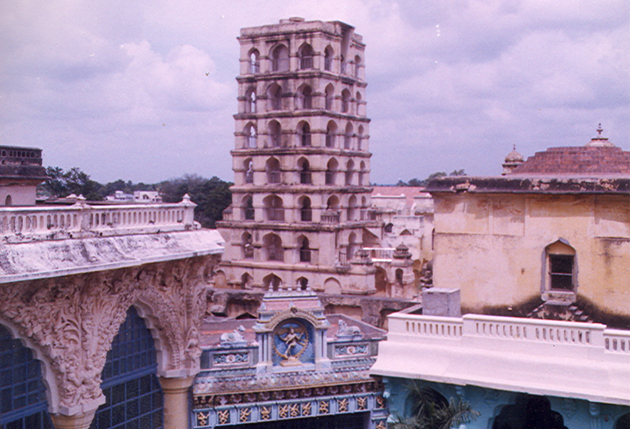THANJAVUR PALACE - THANJAVUR
HISTORICAL BACKGROUNDS :
Arsenal tower:
The Arsenal tower is also called Indhira mandhiram. It was the bedroom of the Nayak Kings and the kings used to stay in any one of the seven floors in the Arsenal Tower. Later the British used the place to store the arms of the Thanjavur Kings. This tower is 190 feet high. During the period of Maratha king, it was being utilized for storing weapons and ammunition and also serving as a watchtower to be on the look out for hostile offensive. Structure of the tower attaracts the admiration of the visitors to Thanjavur even as the vimanam of the Big Temple does.
Due to natural effect and its age, certain portions were damaged and it have been repaired and cleaned thoroughly. Preservative chemical coating was also given after sealing the cracks. Withered and worn-out parts of wooden rafters & beams were removed and
replaced. the pinnacle support of the kalasa was removed and replaced with Illuppai wood Plastering work has been preserved traditionally without changing its aesthetic value.
Bell tower:
This tower is situated to a little north west of the Arsenal Tower. Originally the Bell Tower used for announcing the time by agoing and blowing of conch shells. At the base of Bell Tower a sculpture of Rajagopalaswamy has installed by the Nayak kings and the place was used for discussion with poets and intellectuals. It was called “Madanagopala Vilasa Mandiram”. Now the public knowns this tower as “the wide-heled ear pavilion.” A research note by Sewel informs “there was a novel clock of sizeable dimensions forming part of the structure in which the figure of a monkey used to strike the gong every hour. The tower is fashioned in the style of Senji Nayaks. In built stairs with more than 100 steps lead us the top most floors.” Provided the walls rose at a later stage in the ground floor have been removed and brought to the light by this by this Department through ASI. In the process several pieces of celadon ware and dolls were unearthed. A small shrine, a miniature tank like construction and a few portraits of royal personages were found in the ground floor. Columns were strengthened and provided barricades for its safeguard.
Sarjah Madi:
The imposing structure attracts attention of the visitors. The ground floor was put up during the Nayak times. The paintings and stucco images found on the wall of this floor belong to the perid 1823-1824ACE. King Sarafoji-II 1830 ACE, added part of the structure. Redundant brick walls and decayed wooden rafters replaced. Plastering on the walls have been restricted. Superfluous colour and white washing were wiped off and brought to the original complexion.
Durbar Hall:
Maratha Durbar Hall called Lakshmivilasam. There were two Durbar halls avilable in this complex. Maratha Durbar Hall used by Maratha kings and another durbar hall in the art gallery now, which was used by the Nayak kings. Both Nayak and Maratha kings used the Maratha durbar hall as the court hall. This hall is place abounding in exquisite mural paintings and a stucco images belongs to the Maratha period. There is a verandah with wooden posts along the frontage of the pavilion. A flight of steps leads us to the durbar hall. Portraits of several Maratha rulers including Serfoji are painted as a mural. The octagonal columns, marvelous arches and walls of hall are adorned with deities images.






